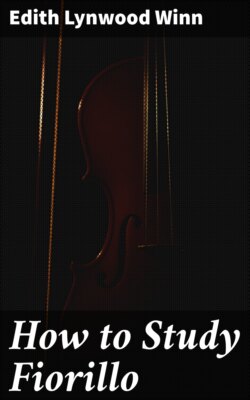Читать книгу How to Study Fiorillo - Edith Lynwood Winn - Страница 7
На сайте Литреса книга снята с продажи.
No. 4.
ОглавлениеTable of Contents
This étude is one of the most useful in the book. A free, broad, slightly detached stroke, in the lower half of the bow, is preferred to a short staccato.
[Listen]
Professor Halir would teach double-stops and scales in thirds in a free, broad style, lower half of the bow (note fingering in the second position).
The whole bow may also be used. Play the scale runs, second line, in the manner outlined in Halir’s Tonleiterstudien (G.B. or U.H. raise the bow after each group).
[Listen]
He assumes that short position movements make a more perfect scale in thirds possible. I will outline the bowings for the next three lines. Keep the theme prominent. Raise the bow slightly from the strings in defining phrasing.
[Listen)]
The double-stops in the higher positions naturally fall in the middle of the bow. Attack the chords with the up bow firmly, and play three notes together. A free, rather detached bowing in the middle of the bow, using the artificial spiccato, occurs at the close.
[Listen]
Slightly accent the slurred group of two notes; raise the bow between strokes. Play in the middle third of the bow.
[Listen]
It is not always advisable to take these études in the order in which they occur. The same rule applies to Kreutzer and Rode. It is possible that the student may have some weak point which requires a review of several études of a similar nature. For instance, I recall having been made to play the second Kreutzer étude[4] many times while studying other works, because my forearm was not free. The eighth and ninth were frequently reviewed. Herr Markees, in Berlin, was a great taskmaster, and frequently sent us back to the twelfth Kreutzer. I do not recall ever having studied the first Kreutzer, nor the famous arpeggio étude. Leopold Lichtenberg, and several other artists, teach both of these. The first is very useful for graduation of tone. In the seventh and eighth Fiorillo we find material for tone graduation. Let us practice the crescendo and decrescendo faithfully, using examples from my “Three Octave Scales.”
We must be patient with this work. It is one of the most difficult things in the world to produce a beautiful crescendo and diminuendo. In connection with this let us turn to the Bach-Gounod “Ave Maria,” and play it as written. The famous Bach “Aria” is another example; also the Handel “Largo.” A question has often been asked: Does the bow remain parallel with the bridge during such work, or at a stated distance from the bridge? Most emphatically not. The bow is nearer the bridge in a crescendo passage, and right over the finger-board in the diminuendo. There is a mistaken notion among students that when one plays pianissimo very little bow must be used. Never was there a greater fallacy. The softest tone is produced by gliding the bow swiftly over the strings, its entire length, without pressure and over the finger-board, not near the bridge.
It is one of the most difficult things in the world to produce a soft, resonant tone. It is easy enough to play loud. So it is with singing. I have learned more about the principles of tone from voice teachers than from violinists. While playing these études, review constantly. Play number one over and over. Number two with the Halir thirds, in C, must be practiced daily. Halir plays double-stops, using the second position instead of the third, and going from second to fourth and sixth. It requires less shifting and is very playable. Always play the double-stops singly, then two slurred, then in groups of four notes, and finally eight notes. After a time play a whole scale up on one box (two octaves C) and down with the opposite bow. Very few amateurs can play the three octave scales thus. I prefer the C scale, as it is easier for the hand. Halir says that a student should be able to play thus (1) or thus (2):
[Listen]
